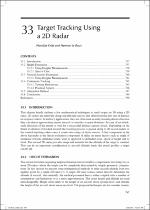JavaScript is disabled for your browser. Some features of this site may not work without it.
- ResearchSpace
- →
- Research Publications/Outputs
- →
- Book Chapters
- →
- View Item
| dc.contributor.author |
Kriel, M

|
|
| dc.contributor.author |
Le Roux, H

|
|
| dc.date.accessioned | 2012-10-22T09:20:54Z | |
| dc.date.available | 2012-10-22T09:20:54Z | |
| dc.date.issued | 2012-08 | |
| dc.identifier.citation | Kriel, M and Le Roux, H. Target tracking using a 2D radar. Mobile Intelligent Autonomous Systems. CRC Press. Florence, KY, USA. pp. | en_US |
| dc.identifier.isbn | 9781439863008 | |
| dc.identifier.uri | http://www.crcnetbase.com/doi/pdf/10.1201/b12690-37 | |
| dc.identifier.uri | http://hdl.handle.net/10204/6200 | |
| dc.description | Copyright: 2012 CRC Press. | en_US |
| dc.description.abstract | This chapter briefly outlines a few mathematical techniques to track targets in 3D using a 2D radar. 2D radars are relatively cheap and efficient sensors that often form the first line of defence in airspace control. In military applications they are often used as early-warning devices because they can detect approaching enemy aircraft or missiles at great distances. In case of an attack, early detection of the enemy is vital for a successful defence against attack. Depending on the threat evaluation of tracked aircraft the tracking process is passed along to 3D search radars or fire control tracking radars once it comes into range of those sensors. A key component in the above hierarchy is the threat evaluation component. It relies on many factors such as angle of incidence towards defended assets, time to approach to defended asset, speed of target and so forth. The normal 2D radar provides range and azimuth but the altitude of the target is omitted. This can be an important consideration as aircraft altitude limits the attack profiles a target can fly. | en_US |
| dc.language.iso | en | en_US |
| dc.publisher | CRC Press | en_US |
| dc.relation.ispartofseries | Workflow;9442 | |
| dc.subject | Target tracking | en_US |
| dc.subject | 2D radar | en_US |
| dc.subject | Aircraft tracking processes | en_US |
| dc.subject | Radar height estimation | en_US |
| dc.title | Target tracking using a 2D radar | en_US |
| dc.type | Book Chapter | en_US |
| dc.identifier.apacitation | Kriel, M., & Le Roux, H. (2012). Target tracking using a 2D radar., <i>Workflow;9442</i> CRC Press. http://hdl.handle.net/10204/6200 | en_ZA |
| dc.identifier.chicagocitation | Kriel, M, and H Le Roux. "Target tracking using a 2D radar" In <i>WORKFLOW;9442</i>, n.p.: CRC Press. 2012. http://hdl.handle.net/10204/6200. | en_ZA |
| dc.identifier.vancouvercitation | Kriel M, Le Roux H. Target tracking using a 2D radar.. Workflow;9442. [place unknown]: CRC Press; 2012. [cited yyyy month dd]. http://hdl.handle.net/10204/6200. | en_ZA |
| dc.identifier.ris | TY - Book Chapter AU - Kriel, M AU - Le Roux, H AB - This chapter briefly outlines a few mathematical techniques to track targets in 3D using a 2D radar. 2D radars are relatively cheap and efficient sensors that often form the first line of defence in airspace control. In military applications they are often used as early-warning devices because they can detect approaching enemy aircraft or missiles at great distances. In case of an attack, early detection of the enemy is vital for a successful defence against attack. Depending on the threat evaluation of tracked aircraft the tracking process is passed along to 3D search radars or fire control tracking radars once it comes into range of those sensors. A key component in the above hierarchy is the threat evaluation component. It relies on many factors such as angle of incidence towards defended assets, time to approach to defended asset, speed of target and so forth. The normal 2D radar provides range and azimuth but the altitude of the target is omitted. This can be an important consideration as aircraft altitude limits the attack profiles a target can fly. DA - 2012-08 DB - ResearchSpace DP - CSIR KW - Target tracking KW - 2D radar KW - Aircraft tracking processes KW - Radar height estimation LK - https://researchspace.csir.co.za PY - 2012 SM - 9781439863008 T1 - Target tracking using a 2D radar TI - Target tracking using a 2D radar UR - http://hdl.handle.net/10204/6200 ER - | en_ZA |






